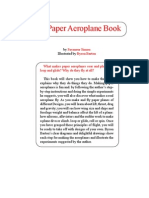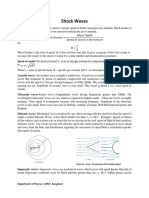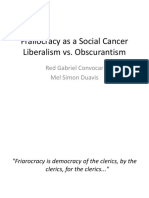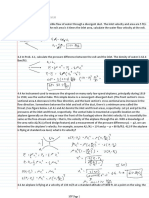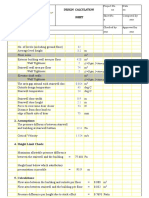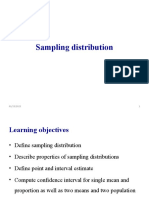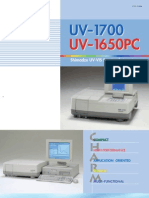Paper Plane
Paper Plane
Uploaded by
suthasenasendramCopyright:
Available Formats
Paper Plane
Paper Plane
Uploaded by
suthasenasendramCopyright
Available Formats
Share this document
Did you find this document useful?
Is this content inappropriate?
Copyright:
Available Formats
Paper Plane
Paper Plane
Uploaded by
suthasenasendramCopyright:
Available Formats
Abstract
Just one sheet of paper can lead to a whole lot of fun. How? Paper planes! All you have to know
is how to fold and you can have a simple plane in a matter of minutes! But what design should
you use to build the best plane? n this aerodynamics science pro!ect" you will change the basic
design of a paper plane and see how this affects its flight. #pecifically" you will increase how
much drag the plane e$periences and see if this changes how far the paper plane flies. %here is
a lot of cool science in this pro!ect" such as how the different forces allow a plane to fly" so get
ready to start folding!
&b!ective
'etermine whether the distance a paper plane flies is affected by increasing how much drag it
e$periences.
ntroduction
Paper airplanes are fun and easy to make. Just fold a piece of paper into a simple plane and
send it soaring into the sky with a flick of your wrist. (atching it float and glide in the air gives
you a very satisfying and happy feeling.
But what allows the paper plane to glide through the air? And why does a paper plane finally
land? %o find out" we will talk about the science behind flying a paper plane and the different
forces that get a paper plane to fly and land. %hese same forces apply to real airplanes" too.
A force is something that pushes or pulls on something else. (hen you throw a paper plane in
the air" you are giving the plane a push to move forward. %hat push is a type of force
called thrust. (hile the plane is flying forward" air is moving over and under the wings and is
providing a force called lift to the plane. f the paper plane has enough thrust and the wings are
properly designed" the plane will have a nice long flight.
But there is more than lack of thrust and poor wing design that gets a paper plane to come back
to )arth. As a paper plane moves through the air" the air pushes against the plane" slowing it
down. %his force is called drag. %o think about drag" imagine you are in a moving car and you
put your hand outside of the window. %he force of the air pushing your hand back as you move
forward is drag. *inally" the weight of the paper plane affects its flight and brings it to a landing.
(eight is the force of )arth+s gravity acting on the paper plane. *igure , below shows how all
four of these forces" thrust" lift" drag" and weight" act upon a paper plane.
Figure 1. When a paper plane is flying, the four forces of thrust, lift, drag, and weight are acting
upon the plane, affecting how well its journey through the air goes.
(ell" what do you think? (ould you like to start e$perimenting with these forces? n this
aerodynamics science pro!ect" you will make a basic paper plane and then slightly alter its
shape to increase how much drag is acting on it. -ou will investigate how far the basic paper
plane flies and compare that to how far it flies when the drag is increased. How will adding drag
affect your plane+s flight? -ou can answer this .uestion with !ust a flick of your wrist.
%erms and /oncepts
*orce
%hrust
0ift
'rag
(eight
1ravity
'ata
2ertical
Accurate
3uestions
(hat is drag and how does it affect airplane flight?
How do you think you could change how much drag a paper plane has?
(hat provides thrust to a real airplane?
Bibliography
%hese sites e$plain how paper planes and airplanes fly.
#haw" 4. 567,7" #eptember ,78. Dynamics of Flight. 4etrieved 9ovember 6:" 67,7"
from http;<<www.grc.nasa.gov<(((<=>
,6<?))%<#tudent#ite<dynamicsofflight.html@forces
%he *ranklin nstitute. 5n.d.8. Forces of Flight Drag. 4esources for #cience 0earning.
-our &wn *light. 4etrieved *ebruary ,:" 67,A"
fromhttp;<<www.fi.edu<flight<own6<drag.html
'oherty" P. 5,BBB8. Paper Airplanes. )$ploratorium CagaDine &nline. 2ol. 6A" 9umber 6.
4etrieved 9ovember 6:" 67,7"
fromhttp;<<www.e$ploratorium.edu<e$ploring<paper<airplanes.html
%he following paper plane pattern is used in this science pro!ect.
0ee" =. 567,6" July 6E8. Basic Dart: Folding Instructions. Amazing Paper Airplanes.
4etrieved *ebruary ,A" 67,A"
fromhttp;<<www.amaDingpaperairplanes.com<BasicF'art.html
%he following resource can be used to convert inches and feet to metric units 5i.e." centimeters
and meters8;
#cience Cade #imple" nc. 5n.d.8. Length conversion using online length converted y
!cience "ade !imple. 4etrieved *ebruary ,A" 67,A"
fromhttp;<<www.sciencemadesimple.com<lengthFconversion.php
*or help creating graphs" try this website;
9ational /enter for )ducation #tatistics" 5n.d.8. #reate a $raph. 4etrieved June 6" 677B"
from http;<<nces.ed.gov<nceskids<createagraph<
)$perimental Procedure
*lying the Planes
,. 1o to the AmaDing Paper Airplanes webpage with folding instructions for the basic dart
design;
a. 0ee" =. 567,6" July 6E8. Basic Dart: Folding Instructions. Amazing Paper
Airplanes. 4etrieved *ebruary ,A" 67,A"
fromhttp;<<www.amaDingpaperairplanes.com<BasicF'art.html
6. *old a piece of paper into the basic dart paper plane following the instructions.
a. *igure , in the Background tab shows an e$ample of a paper plane made using
the basic dart paper airplane design.
b. Cake sure that you fold carefully and that your folds are as sharp as possible.
c. n step G of the folding instructions" skip the optional step of bending up the
tailing edge of the wings.
A. 4epeat step 6 two more times so that you have a total of three paper planes. %hey
should all look identical.
:. Cake a data table in your lab notebook" like %able , below" where you can record the
data you get from your e$periment.
Paper Plane Flight 1 Flight 2 Flight 3 Flight 4 Flight 5 Aerage
Plane 1
Plane 1 with Added
!rag
Plane 2
Plane 2 with Added
!rag
Plane 3
Plane 3 with Added
!rag
Table 1. n your lab notebook" create a data table like this one. *or each flight" write down how
far the paper plane travels 5in centimeters HcmI or meters HmI8.
E. 1o to a large area to fly your paper plane. Cake sure that there is no foot or car traffic at
the area. A long hallway or your school gym is a good location. f you are flying your
plane outside" like in a baseball field or on a basketball court" do your e$periment on a
day when there is no wind.
G. %ear off a E>foot>long piece of masking tape and tape it to the ground in front of you"
going from left to right. %his will be the starting line from which you will fly the paper
planes. f you are doing this science pro!ect outside" you could use a line of sticks or
rocks to mark the starting point.
J. Practice throwing or launching the paper planes. -ou will want to launch the planes in
e$actly the same way every time. Hold the planes at e$actly the same spot on the plane
every time you launch a plane.
K. &nce you have finished practicing" it is time to start the e$periment. Place your toe on
the starting line you prepared earlier and then throw one of your planes.
B. ?se the tape measure to measure how far 5in centimeters or meters8 the paper plane
flew from the starting line. 4ecord this distance in the data table in your lab notebook.
a. %his will be L*light ,L for LPlane ,.L
b. #cience is done in metric units 5e.g." centimeters and meters8 so your data
should be written as such. f your tape measure does not have metric units" you
can convert inches or feet to centimeters or meters using this website;
i. #cience Cade #imple" nc. 5n.d.8. Length conversion using online length
converter y !cience "ade !imple. 4etrieved *ebruary ,A" 67,A"
from http;<<www.sciencemadesimple.com<lengthFconversion.php
,7. 4epeat steps K>B four more times using the same plane" trying to throw the plane as
similarly as possible. 'oing these repeats will help ensure that your data is accurate and
reproducible.
a. Before you fly the plane" make sure that it is in good condition and that the folds
and points are still sharp.
b. 4ecord the distances in the data table in your lab notebook all in the same row
as LPlane ,"L as L*light 6"L *light A"L L*light :"L or L*light E.L
,,. &nce you have flown plane , five times" change the plane to increase its drag.
a. 0ook at the back of the plane" where the wings meet the ridge in the middle.
b. ?sing scissors" cut slits that are 6.E cm long right where either wing meets the
middle ridge.
c. *old up the 6.E cm cut section on both wings so that these sections are at about
a B7 degree angle from the rest of the wing" as shown in *igure 6 below.
d. How do you think this increases the plane+s drag?
Figure 2. "o increase the paper plane#s drag, first cut slits 2.5 c$ long where the wing $eets the
ridge at the %ac& of the plane, and then fold these cut sections up. 'ach wing should now hae a
2.5 c$ long section at the end of the wing that is folded up, at a%out a () degree angle fro$ the
rest of the wing, as shown in these pictures ta&en fro$ different angles.
,6. ?sing plane , with added drag" repeat steps K>,7.
a. 4ecord the distances the plane flies in your data table in the row titled LPlane ,
with Added 'rag.L
b. n your lab notebook" record any observations about how this plane appears to
fly compared to how plane , flew before you added drag.
,A. 4epeat steps K>,6 using one of the other two planes you made 5in step 68.
a. 4ecord the distances the plane flies in the row titled LPlane 6L and then LPlane 6
with Added 'ragL once you repeat step ,:.
b. n your lab notebook" record any observations you make.
,:. 4epeat steps K>,6 using the last of the three planes you made 5in step 68. 5%his plane
should not have been flown previously.8
a. 4ecord the distances the plane flies in the row titled LPlane AL and then LPlane A
with Added 'ragL once you repeat step ,:.
b. n your lab notebook" record any observations you make.
AnalyDing -our 'ata
,. ?sing the data you collected in the data table in your lab notebook" calculate the
average distance that each plane traveled" with and without added drag. 4ecord your
results in the column labeled LAverageL in the data table.
a. *or e$ample" if plane , traveled :.G7" :.,:" E.77" E.AA" and A.KG meters on flight
," 6" A" :" and E" respectively" to figure out its average distance you would first
add these five distances together 5which gives you 66.BA m8 and then divide this
number by five" which gives you an average distance of :.EB meters.
6. ?se the data from your data table to create a bar graph.
a. -ou can plot your data by hand or you can plot your data online at /reate A
1raph.
b. 0abel the $>a$is 5the horiDontal a$is8 LPaper PlaneL and label the y>a$is 5the
vertical a$is8 LAverage *light 'istance.L -ou will have si$ bars" one for each of
the planes without added drag" and one for each of the planes with added drag.
Cake each bar go up to the average distance that plane traveled.
A. (hat does your graph tell you? How did adding drag to your paper planes affect how far
they flew?
a. /an you e$plain your results in terms of how forces allow a plane to fly? %int: 4e>
read the ntroduction in the Background tab.
2ariations
'oes siDe matter? Cake planes of different siDes but keep the design and the type of
paper you use the same. 'o bigger planes fly further?
'o more complicated planes fly further? n order words" does the number of folds that
you use to make a paper plane affect the distance that it flies? %ry this out using the
same siDe and type of paper.
'oes the type of paper you use affect how far the paper plane flies? %ry making paper
planes out of different types of paper" such as printer paper" construction paper" and
newspaper. Cake all of the planes using the same design and fly them as similarly as
you can. 'oes one type of paper seem to work best for making paper planes? 'oes one
type work the worst? -ou may need to do several trials to see a trend.
#ome people like to add paperclips to their paper planes to make them fly better. But
where should the paper clips be placed for the best flight? %ry adding paperclips to the
back" the front" the middle" or the wings. -ou can add one paper clip or several" but try to
be consistent with how many you use. %ake notes in your lab notebook so you know
what you tested. 'oes adding paperclips somewhere make the paper plane+s flight
better" worse" or have no effect at all?
What Makes Paper Airplanes Fly?
Aerodynamics
(hat makes a paper airplane fly? Air M the stuff that+s all around you. Hold your hand in front of your
body with your palm facing sideways so that your thumb is on top and your pinkie is facing the floor.
#wing your hand back and forth. 'o you feel the air? 9ow turn your palm so it is parallel to the ground
and swing it back and forth again" like you+re slicing it through the air. -ou can still feel the air" but your
hand is able to move through it more smoothly than when your hand was turned up at a right angle. How
easily an airplane moves through the air" or its aerodynamics" is the first consideration in making an
airplane fly for a long distance.
Drag and Gravity
Planes that push a lot of air" like your hand did when it was facing the side" are said to have a lot of
Ldrag"L or resistance" to moving through the air. f you want your plane to fly as far as possible" you want a
plane with as little drag as possible. A second force that planes need to overcome is Lgravity.L -ou need to
keep your plane+s weight to a minimum to help fight against gravity+s pull to the ground.
Thrust and Lift
L%hrustL and LliftL are two other forces that help your plane make a long flight. %hrust is the forward
movement of the plane. %he initial thrust comes from the muscles of the LpilotL as the paper airplane is
launched. After this" paper airplanes are really gliders" converting altitude to forward motion. 0ift comes
when the air below the airplane wing is pushing up harder than the air above it is pushing down. t is this
difference in pressure that enables the plane to fly. Pressure can be reduced on a wing+s surface by
making the air move over it more .uickly. %he wings of a plane are curved so that the air moves more
.uickly over the top of the wing" resulting in an upward push" or lift" on the wing.
The Four Forces in Balance
A long flight occurs when these four forces M drag" gravity" thrust" and lift M are balanced. #ome planes
5like darts8 are meant to be thrown with a lot of force. Because darts don+t have a lot of drag and lift" they
depend on e$tra thrust to overcome gravity. 0ong distance fliers are often built with this same design.
Planes that are built to spend a long time in the air usually have a lot of lift but little thrust. %hese planes
fly a slow and gentle flight.
Forces of Flight * !rag
"he drag of the air $a&es it hard for the plane to $oe +uic&ly. Another na$e for
drag is air resistance.
What#s a good shape for getting through the air,
A strea$lined shape slips s$oothly through the air. A wind tunnel can %e used to
show how the air $oes.
Who needs a lot of drag,
!rag can %e a useful force for slowing things down. A %ig area gies $ore drag.
-ae you eer felt the force of drag,
.ou don#t notice the air#s drag when you wal& or run. /ut you feel the force of
drag when you try to $oe through water. Fish and dolphins $ust hae a
strea$lined shape to reduce their drag.
0"here#s $ore drag in water than in air, %ecause it is denser1.
Why is the force of drag i$portant to insects,
A large insect, li&e a dragonfly, $oes easily through the air.
2ife is $uch harder for s$all insects. !rag has a $uch %igger effect if you are
s$all. For a gnat, flying $ight feel a %it li&e swi$$ing.
!rag is $ore of a pro%le$ if you are s$all, and if you want to $oe fast.
Try a related activity...
Fast Fall, 3low Fall
4deas in the /ath
Falling through Water
Paper Airplane Science Fair Project
We've all played with paper airplanes. But a paper airplane science fair
project? Come on. Get serious.
Yep! We're serious. And you'll find this is one of our etter projects too. !ust
follow the instructions elow" and you'll have yourself a #reat project and a
#ood time to oot! $o...
%et's #et started...
Time & Give yourself aout one wee' to do this one.
Stuff List
You'll need...
1. (ou#h li#htwei#ht paper for ma'in# airplanes )copy paper wor's
wonderfully*
2. +aper airplane instruction oo' )recommended ut not re,uired.*
[We recommend Champion Paper Airplanes by Paul Jackson,
Reisterstown, ! "lyin# "ro# 1$$$%
&. Conversion tale and calculator
'. (ape measure
(. +encil or pen
). +aper
*. Graph paper
+. Camera
$. Cardoard for display )three sided*
1,. Glue
11. +aper
12. Computer )optional*
Preparation
-ven with a paper airplane science fair project )which sounds ,uite simple*
we need to ecome scientists. And a #ood scientist always as's ,uestions.
$o...
...let's as' some ,uestions aout paper airplanes. (hese ,uestions are only
for reference so we can #et our feel for the project. We'll as' ourreally
im-ortant .uestion a little it later. %et's thin' aout our paper airplane
science fair project for a little it and as' ourselves...
What is a paper airplane?
What ma'es it fly?
Are there different 'inds of airplanes?
(horou#hly research these and any other ,uestions you can thin'. .ind all
you can aout different 'inds airplanes. As' an adult aout it" or #et on the
internet. You mi#ht even find some #ood oo's on paper airplanes at the
lirary. /f you really wanted to #et serious" you could plan a 0field trip0 to the
airport to find out how real airplanes wor'.
+ut a lot of effort into this part. /t'll ma'e your life simpler later. After you've
done your research" as' the im-ortant .uestion. (his is also called
your /y-ot/esis...
!oes t/e number of folds affect t/e distance a -a-er air-lane will
fly0
(his is a #ood ,uestion ecause we can try it out in a lar#e" empty room in
our house or outside. But don't try it yet. We need to answer our important
,uestion first!
%et's do that now.
What do you thin' will happen?
1oes the numer of folds affect the distance a paper airplane will fly?
Write down your #uess on a piece of paper. 1on't chan#e it until you see
what your paper airplane science fair project does first. 2ememer...
...we call this #uess our /y-ot/esis. /t's the most important part of our
paper airplane science fair project!
3ow it's time to #et your stuff from the list aove. %et's move to the ne4t
step.
Project
3ow comes the fun part...
...let's e4periment!
.irst" we'll need to ma'e five different patterns of planes for this paper
airplane science fair project. You'll proaly want to ma'e three airplanes
from each pattern. But don1t c/eat2 You're not allowed to add wei#ht or
anythin# else to it to ma'e it fly etter. (hat will ruin the e4periment!
What we're tryin# to discover is how the folds affect the way the plane flies.
$o don't try any other modifications other than foldin# it a different numer
of times and in different ways. (rust us...
You won't need e4tra wei#ht for these planes to fly. )1on't worry. We've
already tried it!!! 5* *
6ere are some #reat e4amples of airplanes...
3ow comes the est part of all...
/t's time to fly them!
(he est place to do this is in an empty room" lon#" wide hallway or )even
etter* the #ym at your school. (he i##er" the etter. (he fewer ostacles
that #et in your way" the less li'ely somethin# will end the loooonnnnn#####
fli#ht of your est plane...
2ecord the distance each one #oes. /f you live in a place that uses standard
-n#lish measures )inches" feet" yards" etc.* you may want to convert your
distances to metric measures )centimeters" meters" etc.* /t ma'es it loo'
more 0scientific.0
Be careful to write all your information down neatly so that you can read it.
You'll use this information later. But it won't do you any #ood if you don't
'now which plane did what or can't read your own handwritin#.
Paper
Alri#ht...
...let's ma'e the chart!
%ael the first column 03umer of .olds.0 3e4t" lael the second column
0(hrow 7ne"0 the second 0(hrow (wo0 and so on. 7nce a#ain" ma'e sure it's
all neat. (he jud#es will loo' for that.
/n this case" you may want to ma'e a ar #raph. /t loo's more
0professional.0 And #raphs are normally easier to read.
%ael across the ottom the numer of folds of each plane. Alon# the side"
write 080" 090" 0:0 and so on all the way up to twenty )9;* or twenty&five
)9<.* Add color to distin#uish etween each type of paper airplane. 6ere are
some e4amples...
.or more info aout ma'in# charts and #raphs clic' here.
/t's time to tell what you've noticed. Write a report aout what you saw.
You should include...
1. What you #uessed aout the paper airplanes.
2. What you did in your paper airplane science fair project.
&. Which numer of folds did the est.
'. /f your #uess was correct aout the numer of folds.
Be careful to oey all the school rules for your science fair report. 7ne or
two para#raphs for each #rade level will do if you weren't #iven how lon# it
should e. Be detailed as well. But ma'e it neat.
Presentation
3ow you #et to ma'e the display!
Carefully put three pieces of cardoard to#ether so it loo's li'e this...
/f you want more information aout how to put to#ether and arran#e
displays for your paper airplane science fair project clic' here.
You can uy displays at many retail stores as well. 6owever you do it" ma'e
sure you follow science fair rules!
3ow" on a piece of paper neatly write your important ,uestion and your
#uess. /f you would li'e" type it. You mi#ht #et style points!
3ow" just li'e you did your important ,uestion" write )or type* your supply
list on a separate piece of paper.
+aste your #uess" supply list and report onto your display oard alon# with
any pictures you mi#ht have ta'en. =a'e sure you lael each so the jud#es
'now what is what. =a'in# sure everythin# loo's #ood is important!
/f you want to #et some ideas for your display we have some e4amples for
you. !ust clic' here for e4amples of displays and other helpful hints to ma'e
your project shine!
(ry playin# with some of the display ideas you see. You don't have to use the
e4act ones we use. =a'e them fun! Be creative!
And don't for#et to name your project at the top of the display oard. /t's
est to use your important ,uestion as the title. You may want to purchase
stencils to ma'e cutouts of letters. 7r you may purchase already made
letters at many retail stores.
We came up with this paper airplane science fair project so you could have
fun and learn at the same time. $o...
Whatever you do" have fun!
You might also like
- The Klutz Book of Paper Airplanes - DOUG STILLINGERDocument58 pagesThe Klutz Book of Paper Airplanes - DOUG STILLINGERale_mantilla96% (28)
- Paper PlanesDocument21 pagesPaper PlanesRohit Patil100% (1)
- Engineering Economy: Name: Hernandez, Arvin D. CH040 - C11Document5 pagesEngineering Economy: Name: Hernandez, Arvin D. CH040 - C11Patricia DavidNo ratings yet
- 1995 Impreza EJ18 ECM PinoutDocument3 pages1995 Impreza EJ18 ECM Pinoutguillermo6661No ratings yet
- Aviation PhysicsDocument3 pagesAviation PhysicsNelson Cervantes ArasNo ratings yet
- The Food Beverage Market Sector in SingaporeDocument5 pagesThe Food Beverage Market Sector in SingaporeRaishaNo ratings yet
- Foodpanda Leads The Sustainability Change: Source: SABRE Awards, Gold, APAC, Food Service, 2018Document5 pagesFoodpanda Leads The Sustainability Change: Source: SABRE Awards, Gold, APAC, Food Service, 2018Salman ManiNo ratings yet
- Paper Airplane HistoryDocument3 pagesPaper Airplane HistoryBrad LancasterNo ratings yet
- G8 Module Q2 W3Document6 pagesG8 Module Q2 W3Novelyn DurezaNo ratings yet
- Shock Waves - 2015Document8 pagesShock Waves - 2015Vedant SharmaNo ratings yet
- The Symbolic Interaction PerspectiveDocument2 pagesThe Symbolic Interaction PerspectiveStacy BenNo ratings yet
- Literature 2Document7 pagesLiterature 2SIMPLEJG100% (1)
- FOCUS and EPICENTER of An EarthquakeDocument18 pagesFOCUS and EPICENTER of An EarthquakeMaria Victoria Ignacio CaseriaNo ratings yet
- Microbial Quality and Safety of Cooked Foods Sold in Urban Schools in Ghana: A Review of Food Handling and Health Implications Ghana A Review of Food Handling and Health ImplicationsDocument10 pagesMicrobial Quality and Safety of Cooked Foods Sold in Urban Schools in Ghana: A Review of Food Handling and Health Implications Ghana A Review of Food Handling and Health ImplicationsresearchpublichealthNo ratings yet
- Module 2 Study NotebookDocument9 pagesModule 2 Study NotebookEarlyn Joy Villaruel EniolaNo ratings yet
- Food Retail in SingaporeDocument36 pagesFood Retail in Singaporepallavigoyal.ca3296No ratings yet
- Frailocracy As A Social CancerDocument37 pagesFrailocracy As A Social CancerRed ConvocarNo ratings yet
- Research Chapter 1 FinalDocument10 pagesResearch Chapter 1 FinalMa Eulydan BayugaNo ratings yet
- Ae 445 HW2Document2 pagesAe 445 HW2R CoppensNo ratings yet
- BAHRM-6120 Entrepreneurial Management - Business Plan - Noe AgubangDocument27 pagesBAHRM-6120 Entrepreneurial Management - Business Plan - Noe AgubangNoe AgubangNo ratings yet
- Chapter 2Document1 pageChapter 2api-523871804No ratings yet
- Law of Conservation of MassDocument5 pagesLaw of Conservation of Massapi-231516879No ratings yet
- Science 8 Q2 WK3Document20 pagesScience 8 Q2 WK3The Decoders DecodersNo ratings yet
- Standard and Non-Standard EnglishDocument12 pagesStandard and Non-Standard EnglishSagnikNo ratings yet
- Chapter 7 Patterns of StruggleDocument5 pagesChapter 7 Patterns of Struggledancena14No ratings yet
- Business Ethics and Social Responsibility Term PaperDocument15 pagesBusiness Ethics and Social Responsibility Term PaperalexanderNo ratings yet
- Sample Problems in BouyancyDocument2 pagesSample Problems in BouyancyJuan HeroNo ratings yet
- National Gallery: Arts Appreciation Summative Assessment 2Document3 pagesNational Gallery: Arts Appreciation Summative Assessment 2Rausa MaeNo ratings yet
- 1 Monitoring The WeatherDocument26 pages1 Monitoring The WeatherMitch HomeNo ratings yet
- Magnitude and IntensityDocument45 pagesMagnitude and IntensityJefrey PaglinawanNo ratings yet
- M4 - L4 - Check in ActivityDocument1 pageM4 - L4 - Check in ActivityWilliam DC RiveraNo ratings yet
- 2017 Scig8q2Document138 pages2017 Scig8q2richardsamrano0% (3)
- How Airplanes WorkDocument20 pagesHow Airplanes WorkMunnabhai.beNo ratings yet
- AirplaneDocument19 pagesAirplaneChitra LoganathanNo ratings yet
- Instruction Set Final DraftDocument5 pagesInstruction Set Final Drafttabrizee nurNo ratings yet
- Paper PlanesDocument5 pagesPaper PlanesLucas OliveiraNo ratings yet
- How Does The Drag Affect The Flight of Paper Planes?Document2 pagesHow Does The Drag Affect The Flight of Paper Planes?pearlvpearlNo ratings yet
- Engineering Design - Week 4 Kritik ActivityDocument2 pagesEngineering Design - Week 4 Kritik Activityishreetgrewal2003No ratings yet
- Elastic Band Airplane 12452573865e8fDocument8 pagesElastic Band Airplane 12452573865e8fCesar QuinterosNo ratings yet
- AeronauticalDocument319 pagesAeronauticalfayasfamiNo ratings yet
- ParachutesDocument2 pagesParachutesKenny SzeNo ratings yet
- Aspect Ratio of WingsDocument6 pagesAspect Ratio of WingsMa Robina Obias CandiaNo ratings yet
- Understanding Flight 2001 AppendexDocument6 pagesUnderstanding Flight 2001 AppendexNayot TientongNo ratings yet
- Fin Surface Aerodynamic Force Flight Propulsion Atmosphere Gaseous Liquid FluidDocument3 pagesFin Surface Aerodynamic Force Flight Propulsion Atmosphere Gaseous Liquid FluidGabriel MarinicăNo ratings yet
- Paper-Airplane-Instructions Marc-Rocas Revised Joshua SmithDocument6 pagesPaper-Airplane-Instructions Marc-Rocas Revised Joshua Smithapi-302830300No ratings yet
- Make A Straw Plane: Activity OverviewDocument6 pagesMake A Straw Plane: Activity OverviewAlexandroNasaStemNo ratings yet
- Amazing Paper Airplanes: The Craft and Science of FlightFrom EverandAmazing Paper Airplanes: The Craft and Science of FlightRating: 4 out of 5 stars4/5 (4)
- Mod 8 28-8-09 Extras PDFDocument60 pagesMod 8 28-8-09 Extras PDFredNo ratings yet
- Space Shuttle GliderDocument3 pagesSpace Shuttle GliderAviation/Space History LibraryNo ratings yet
- Aero Dynamic Design: Cindy CampDocument2 pagesAero Dynamic Design: Cindy CampFeynmanFanNo ratings yet
- AFS Paper Airplanes: Incredible Designs You Can Make at HomeFrom EverandAFS Paper Airplanes: Incredible Designs You Can Make at HomeRating: 5 out of 5 stars5/5 (1)
- Paper Stomp Jets: Step 1: The LauncherDocument9 pagesPaper Stomp Jets: Step 1: The LauncherKatlyn ShumakeNo ratings yet
- Play With The Sims Motion The Ramp: - Equal - 980N - 294 NDocument3 pagesPlay With The Sims Motion The Ramp: - Equal - 980N - 294 NuflillaNo ratings yet
- Prototype Hover Craft Project ReportDocument7 pagesPrototype Hover Craft Project ReportRoundElephantNo ratings yet
- Desen AvionDocument69 pagesDesen AvionDiman IonutNo ratings yet
- ScienceprojectlabreportDocument5 pagesScienceprojectlabreportapi-321988186No ratings yet
- Cessna 182 SkylaneDocument6 pagesCessna 182 SkylaneAviation/Space History LibraryNo ratings yet
- Aerodynamics of Paper AirplanesDocument16 pagesAerodynamics of Paper AirplanesBrindleSmith111100% (1)
- What Is A StallDocument12 pagesWhat Is A StallTheStephen Michael BoodhooNo ratings yet
- Bell 47 HelicopterDocument4 pagesBell 47 HelicopterAviation/Space History Library100% (1)
- Devotion Song LyricDocument3 pagesDevotion Song LyricsuthasenasendramNo ratings yet
- Jadual Spesifikasi Ujian (Jsu) 2017 Bahasa Inggeris Tahun Satu Penulisan SJKDocument3 pagesJadual Spesifikasi Ujian (Jsu) 2017 Bahasa Inggeris Tahun Satu Penulisan SJKsuthasenasendram100% (2)
- The Tiny SeedsDocument4 pagesThe Tiny SeedssuthasenasendramNo ratings yet
- Essay Writing TableDocument2 pagesEssay Writing TablesuthasenasendramNo ratings yet
- Read The Notes Below and Use The Information To Complete The TextDocument5 pagesRead The Notes Below and Use The Information To Complete The TextsuthasenasendramNo ratings yet
- Daily Lesson Plan Year 2: AttendanceDocument44 pagesDaily Lesson Plan Year 2: AttendancesuthasenasendramNo ratings yet
- English Paper 1 Yr 6-2018Document13 pagesEnglish Paper 1 Yr 6-2018suthasenasendramNo ratings yet
- A. Group The Words Correctly.: Fourteen Red Yellow Pen Chair Eleven Eight Three Purple Blue DeskDocument5 pagesA. Group The Words Correctly.: Fourteen Red Yellow Pen Chair Eleven Eight Three Purple Blue DesksuthasenasendramNo ratings yet
- History TornadoDocument3 pagesHistory TornadosuthasenasendramNo ratings yet
- Who/Name Verb What/when/why/where Who/Name Verb What/when/why/whereDocument2 pagesWho/Name Verb What/when/why/where Who/Name Verb What/when/why/wheresuthasenasendramNo ratings yet
- Buku Program NILAMDocument3 pagesBuku Program NILAMsuthasenasendramNo ratings yet
- Allied Consultants LTD.: XXXX XXXX 1. Input DataDocument4 pagesAllied Consultants LTD.: XXXX XXXX 1. Input DataNelson VargasNo ratings yet
- Robert - Andrew - Day 1990 PHD Thesis PDFDocument254 pagesRobert - Andrew - Day 1990 PHD Thesis PDFNaren David GonzalezNo ratings yet
- TD Synchrobelt HTD enDocument77 pagesTD Synchrobelt HTD enDavid BaylissNo ratings yet
- IWJasdasdDocument12 pagesIWJasdasdAlfredo FernandoNo ratings yet
- Journal of Rock Mechanics and Geotechnical Engineering: Saurabh Rawat, Ashok Kumar GuptaDocument11 pagesJournal of Rock Mechanics and Geotechnical Engineering: Saurabh Rawat, Ashok Kumar GuptaHari RamNo ratings yet
- Elcb & RCDDocument18 pagesElcb & RCDKhay SaadNo ratings yet
- Daily Delay Measure1 PDFDocument9 pagesDaily Delay Measure1 PDFDeejaay2010No ratings yet
- AI Primer: A Business Perspective On AIDocument11 pagesAI Primer: A Business Perspective On AImy VinayNo ratings yet
- Narrow Gap Submerged Arc WeldingDocument7 pagesNarrow Gap Submerged Arc Weldingajithkumar mNo ratings yet
- Concave and Convex LensDocument7 pagesConcave and Convex LensannmarieNo ratings yet
- Ac Motors World Energy Regulations Guideline Iss201911 B 5708Document12 pagesAc Motors World Energy Regulations Guideline Iss201911 B 5708ManchoNo ratings yet
- Smart: Journal of Business Management StudiesDocument0 pagesSmart: Journal of Business Management StudiesvlkantetiNo ratings yet
- NtbtlogDocument99 pagesNtbtlogzaki marufanNo ratings yet
- Developments in Electric Power Supply Configurations For Electrical-Discharge-Machining (EDM)Document6 pagesDevelopments in Electric Power Supply Configurations For Electrical-Discharge-Machining (EDM)فایلجو پروژه و مقالهNo ratings yet
- Mo CVD Material GrowthDocument19 pagesMo CVD Material GrowthTuan Anh NguyenNo ratings yet
- IPMPLS - Analysis - Qos - JSAER2024 11 1 222 230Document10 pagesIPMPLS - Analysis - Qos - JSAER2024 11 1 222 230Abdoulrazak HamanNo ratings yet
- C-7 Sampling DistribuDocument109 pagesC-7 Sampling DistribuBiruk MengstieNo ratings yet
- Datasheet Fike Monitor Module 55-041Document2 pagesDatasheet Fike Monitor Module 55-041roni kurniawanNo ratings yet
- Higher Nitec in Civil & Structural Engineering Design: Course Synopsis Course StructureDocument3 pagesHigher Nitec in Civil & Structural Engineering Design: Course Synopsis Course StructuregohtsNo ratings yet
- Review of Graininess MeasurementsDocument14 pagesReview of Graininess MeasurementsIrvin MarotzNo ratings yet
- Shimadzu Spectrophotometer UV1700 & UV1650PCDocument24 pagesShimadzu Spectrophotometer UV1700 & UV1650PCAldi Igniel100% (1)
- Iass2015 547665Document13 pagesIass2015 547665yousef aklNo ratings yet
- BX 40Document33 pagesBX 40darka EisenkolbNo ratings yet
- Advanced Rubik's Cube - Fridrich First Two Layers - F2LDocument9 pagesAdvanced Rubik's Cube - Fridrich First Two Layers - F2LNishad Mandlik100% (1)
- Mohan Ty 2014Document4 pagesMohan Ty 2014Anurtha AnuNo ratings yet
- ADS Matching and OptimizationDocument18 pagesADS Matching and OptimizationThanhha NguyenNo ratings yet
- Amat 2010 - Investigation of Spectroscopic Properties of Indigo BlueDocument9 pagesAmat 2010 - Investigation of Spectroscopic Properties of Indigo BlueKaterina MarnellouNo ratings yet
- Unit - 4 1 Mark QuestionsDocument6 pagesUnit - 4 1 Mark QuestionsSangamesh ShettarNo ratings yet
- Table of Specification Mathematics VI Second Periodical TestDocument5 pagesTable of Specification Mathematics VI Second Periodical TestTrixie A CruzatNo ratings yet

